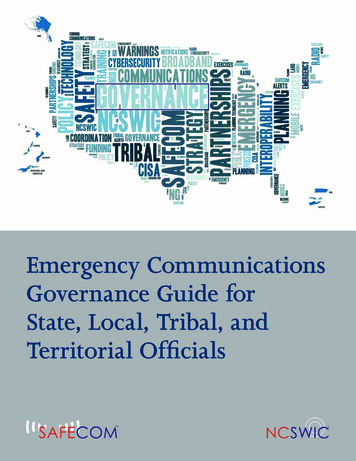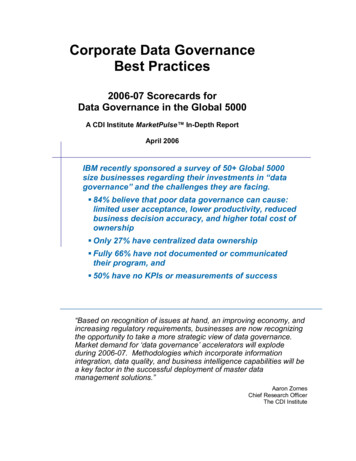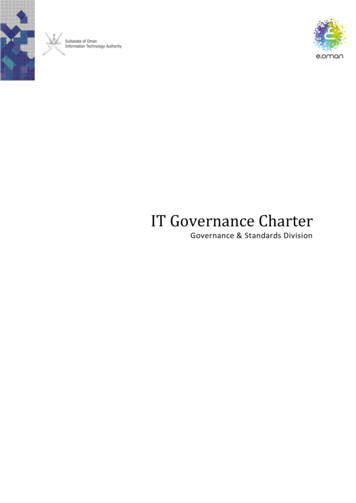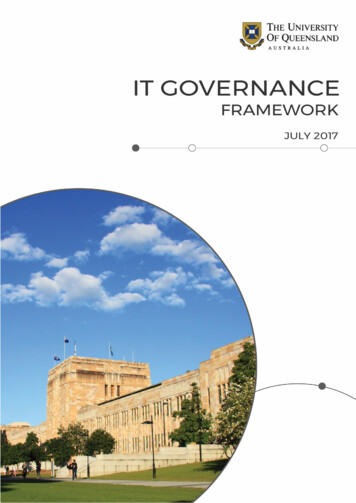
Transcription
Emergency CommunicationsGovernance Guide forState, Local, Tribal, andTerritorial Offcials
Version Control TableRevision DateSummary of UpdatePage(s)April 2019Ecosystem graphic and table updated to align with 2019 National EmergencyCommunications Plan (NECP)4, 5April 2019Miscellaneous typesetting changesv, 20, 30, 38, 48, B-1Emergency Communications Governance Guide for State, Local, Tribal, and Territorial (SLTT) Officials i
Letter from the SAFECOM, NCSWIC,and Governance Guide Working Group ChairsEngaged and effective governance is a critical componentof successful interoperable emergency communications.The SAFECOM and National Council of StatewideInteroperability Coordinators (NCSWIC) membersvalue effective governance but recognize it as one ofthe greatest challenges encountered by emergencycommunications offcials. Establishing and maintainingeffective governance across state, local, tribal, andterritorial (SLTT) entities is a complex process, especiallyin the constantly evolving communications landscape.Strong leadership and governance improve planning,coordination, and decision-making, raising awarenessof communications issues, and enhancing coordinationacross all levels of government.The 2018 Governance Guide for State, Local,Tribal, andTerritorial Emergency Communications Offcials (GovernanceGuide) builds on the 2015 Governance Guiderelease.This Governance Guide provides publicsafety professionals, at all levels of government anddisciplines, tools to establish and sustain effectiveemergency communications governance. It describesGerald ReardonSAFECOM Chairfunctional areas applicable to the SLTT audiencecentered on interoperability coordination. TheGovernance Guide also strives to highlight tribalemergency communications best practices, lessonslearned, capabilities, challenges, and partnerships whileconsidering unique emergency management structuresof federally recognized tribes.Developed with input from a wide array of respondersacross the country, this guide outlines governancechallenges, best practices, and recommendations.While information is not intended to be restrictiveor mandated, the broad approach allows emergencycommunications offcials to apply the governancemodel most appropriate for their jurisdiction.SAFECOM, NCSWIC, and the members of theGovernance Guide Working Group are committedto enabling engaged and effective governance thatsupports life-saving emergency communicationscapabilities across the Nation.Nikki CassinghamNCSWIC ChairDaniel MartinezGovernance Guide Working Group ChairEmergency Communications Governance Guide for State, Local, Tribal, and Territorial (SLTT) Officials i
Executive SummaryThe Department of Homeland Security (DHS)Cybersecurity and Infrastructure Security Agency(CISA), in coordination with SAFECOM and theNational Council of Statewide InteroperabilityCoordinators (NCSWIC), presents the 2018 GovernanceGuide for State, Local,Tribal, and Territorial EmergencyCommunications Officials (Governance Guide). Sincethe 2015 release of the Governance Guide, CISAconducted the SAFECOM Nationwide Survey tocollect data on existing public safety communicationscapabilities and gaps. The survey found strongleadership and governance structures are improvingemergency communications planning, coordination,and decision-making. However, the fndings alsorecognized continued challenges involving newentities beyond traditional responders, as well asintegrating emerging technologies into public safetycommunications systems.To assist state, local, tribal, and territorial (SLTT)offcials overcome these challenges, the 2018Governance Guide empowers agencies to establish,assess, and update governance structures that supportinteroperable emergency communications. While theinformation provided is not intended to be restrictiveor mandated, the broad approach allows offcials toapply the governance model most appropriate fortheir jurisdiction.The Governance Guide holisticallyexamines interoperable emergency communicationsgovernance structures, including best practices andguidance for public safety agencies to: Understand the governance landscape, includinghow governance bodies coordinate communicationstechnologies (e.g., land mobile radio, broadband,911, alerts, warnings, and notifcations) andoperational sustainment functions (e.g., cybersecurity,public-private partnerships, non-governmentalorganizations with supporting roles, training,exercise, and evaluation programs). Build partnerships between response organizationsat all levels of government, fostering interactionbetween different departments, agencies, andjurisdictions, as well as formalizing cooperationthrough written agreements. Establish a governance structure and formaldecision-making processes through authorities,charters, by-laws, resolutions, and strategic plans. Choose a governance model that refects the uniqueorganization, needs, and potential partners of eachemergency communications ecosystem. Engage in governance, including considerations forcommunications lifecycle planning, coordinationwith other governance groups, and integration ofemerging technologies. Enhance governance by establishing mechanismsto measure outcomes and identifying solutionsto common governance, legal, fscal, andtechnological challenges.Engaged and effective governance is pivotal tooperable, interoperable, and continuity of emergencycommunications. Robust governance establishes andmaintains a central coordination point for effortsacross the broad spectrum of public safety partnersand the whole community, as well as helps to addresschallenges in a unifed manner. Successful planning,implementation, and execution of a governancestructure requires dedicated time and resources. Whilethis investment may appear daunting, it will deliversolutions that beneft the public safety community,supporting entities, and ultimately citizens of thisNation. The Governance Guide, developed with and foruse by emergency communications offcials, offers theguidance needed to successfully establish, sustain, andenhance SLTT governance structures.iii
CONTENTS02 Introduction03 Scope andMethodology04 Governance in theInteroperabilityContinuum06 Characteristicsof EffectiveGovernance07 Governance Rolesand Responsibilities10 Understand theGovernanceLandscape11 CommunicationsTechnologyFunctions14 OperationalSustainmentFunctions20 Build Partnerships21 DevelopMemoranda ofUnderstanding/Memoranda ofAgreements24 Establish FormalGovernanceStructures24 Authorities25 Chartersand by-laws27 Resolutions28 Strategic Plans16 InteroperabilityCoordination“You can have all the technology you want but you will not achieve true interoperability if youdo not have the cooperation and the collaboration that comes with the governance structure thatensures everyone is working together, making joint decisions, spending funds with others in mind.”– SAFECOM Executive Committee Chair Marilyn J. Praisneriv
30 Choose aGovernanceStructure30 Structures30 Models34 Organization38 Engage inGovernance42 EnhanceGovernance38 Lifecycle Planning42 OrganizationalChallenges39 Coordinating withRelated GovernanceGroups40 Measuring Success43 Legal Challenges43 Funding Challenges45 TechnologicalChallenges48 Conclusion49 References55 AcronymsA-1 Appendix A –PositionDescriptionsB-1 Appendix B –Native AmericanTribal Recognitionby State2018 SAFECOM Emergency Communications Governance Guidefor State, Local, Tribal, and Territorial Offcials Working GroupMembership was made up of 31 Emergency ManagementProfessional State, Tribal, Association, and Federal partnersEmergency Communications Governance Guide for State, Local, Tribal, and Territorial (SLTT) Officials v
INTRODUCTION
IntroductionIn an increasingly complex and interconnected emergency communicationsecosystem, public safety agencies must consider the various functions andpeople that exchange information prior to, during, and after incidents. Similarly,agencies are integrating new and emerging communications technologiesthat must be interoperable with existing systems and across partner entities.With this integration of capabilities and partners, a single agency cannot solvecommunications operability, interoperability, and continuity alone. Effectivecommunications require a partnership among response entities across all levelsof government and disciplines to ensure the right information gets to the rightpeople at the right time. A strong governance framework to plan, collaborate,and make decisions brings together all relevant participants with a stake inemergency communications.The SAFECOM Nationwide Survey (SNS), a publicsafety data collection effort conducted from Januarythrough March 2018, included input from federal,state, local, tribal, territorial, urban and ruralcommunities, as well as across the span of publicsafety disciplines. The SNS data reported mostemergency communications-focused governancebodies are comprised of both formal and informaldecision-making groups, with very few bodiesproactively seeking new partners.1 SNS data alsofound few state or local organizations engaging incommunication planning with federal agencies,SAFECOM Nationwide Survey results: s/FINAL SNS National-Level%20Random%20Sample%20Results 08092018.pdf.12
tribal entities, or private sector/non-governmentalorganizations (NGOs). In addition, over a thirdof organizations indicated that cybersecurityincidents had an impact on the ability of theiremergency response providers and governmentofficials’ ability to communicate over the pastfive years. However, only 9 percent identifiedaddressing cybersecurity in their training and only16 percent of organizations include cybersecurityin their organization’s standard operatingprocedures (SOPs). These findings highlight theneed for governance structures to evolve andbroaden membership, as well as address rapidtechnology advancements. Cohesive governancestructures representing the whole community willprovide greater perspectives into the strengths,weaknesses, opportunities, and threats to emergencycommunications systems.The Importance of Governance The frst goal of the National EmergencyCommunications Plan (NECP), the Nation’sstrategic plan to improve emergencycommunications, calls to strengthengovernance and leadership The National Governors Association (NGA),in its Improving Emergency Communications ThroughGovernance white paper, calls governancethe most critical element to ensuringinteroperability of emergency communications The SNS pointed out broadeninggovernance body membership asa key governance challengeSources: NECP, NGA, SNS3Establishing formal governance to improvecommunications can be challenging when “businessas usual” includes a resistance to change and siloeddecision-making. To prepare state, local, tribal, andterritorial (SLTT) partners for today’s challenges,SAFECOM, the National Council of StatewideInteroperability Coordinators (NCSWIC), and theDepartment of Homeland Security (DHS) Cybersecurityand Infrastructure Security Agency (CISA) developedthe 2018 Emergency Communications Governance Guide for State,Local,Tribal, and Territorial Offcials (Governance Guide) to: Highlight proven, repeatable models of emergencycommunications governance structures. Provide SLTT governing bodies with information andguidance for creating and managing an emergencycommunications governance structure. Demonstrate tribal emergency managementbest practices and lessons learned, includingcommunications capabilities, activities, partnerships,and funding opportunities and challenges.Scope and MethodologyThe Governance Guide is a resource for governingbodies at all levels of government, recognizing thatthere is no “one size fts all” approach. It is intendedto help elected or appointed offcials, policy makers,planners, emergency managers, frst responders,and the whole community form governance structuresto support reliable, secure, and interoperable publicsafety communications.To develop this document, SAFECOM and NCSWICconvened a working group comprised of public safetyexperts that interviewed SLTT agencies across thecountry. Interviews focused on the establishment andevolution of governance authorities. They also identifedexisting governance membership composition,organization and structure, measures of success,funding mechanisms, and engagement. As a result, theinterviews captured examples of successful activities,challenges, best practices, and characteristics of effectivegovernance that are included within this document.
Governance in theInteroperability ContinuumThe emergency communications ecosystem is dynamic—not everyone is needed every day depending on theincident, events, access to information, and technologiesused—and it is also multi-directional, as anyone caninitiate emergency communications. By first understandingthe ecosystem and unique needs in their area, agencies canthen tackle challenges to achieving reliable, secure, andinteroperable communications at any time. The ecosystemis comprised of: networks of people, technology, andprocesses. Together, these components create a “systemof systems” that plays an important part in ensuring theoperability, interoperability, and continuity of emergencycommunications. Figure 1 and Table 1 describe theEmergency Communications Ecosystem.Figure 1: Emergency Communications EcosystemEmergency Communications Governance Guide for State, Local, Tribal, and Territorial (SLTT) Officials 4
Table 1: Ecosystem DescriptionCommunications FunctionsPurposeExamplesReporting &Requesting AssistanceUrgent and non-urgent requests or informationsharing made to public safety resources usingdefned emergency and non-emergency paths911, 311, dedicated numbers, tip lines, alarmactivated, face-to-face, triggered telematics system,social media, web applications, detectionof serviceoutages or disruptionsIncident Coordination& ResponseDirect voice and data communications amongpublic safety responders, emergency communicationcenters/public safety answering points, andemergency support systems to establish commandand control, situational awareness, and sharedcommon operating pictureInformation sharing, joint planning, radiocommunications, in-feld operations, data exchangeAlerts, Warnings,& NotifcationsInstructional messages directing protectiveactions to save lives and property, and conveytime-sensitive information for preparation,response, and recovery-related servicesActive threats or civil dangers, hazmat, AMBERalerts, weather watches, fre warnings, evacuationorders, area accessibility updates, all-clear notices,Emergency Alert System, Wireless Emergency AlertsPublic InteractionPublic's sharing of information through various publicor commercial networks supporting the Internet,social media, and telephony communicationsTelephone calls, social media, such as Facebook,Twitter, web services and applicationsFigure 2: SAFECOM Interoperability Continuum5 Emergency Communications Governance Guide for State, Local, Tribal, and Territorial (SLTT) Officials
Figure 2 depicts the SAFECOM InteroperabilityContinuum, a tool that identifes the fve criticalsuccess elements that must be addressed to achieve asophisticated interoperability solution: governance,SOPs, technology, training and exercises, and usage ofinteroperable communications.The InteroperabilityContinuum can be used by jurisdictions to track progressin strengthening interoperable communications.Governance is widely regarded as the most challengingelement of the Interoperability Continuum because ofthe diffculty in bringing people together with differentviewpoints from various geographies to support acommon vision.The signifcance of governance isfurther demonstrated in that all other elements aremanaged or facilitated through governance. Governanceserves as the framework for SLTT representatives tocollaborate and make decisions that establish a sharedapproach for improving communications.Characteristics ofEffective GovernanceEffective governance fosters collaboration between publicsafety partners, emergency communications offcials,and members of the whole community. Governancestructures facilitate a greater understanding of existingcommunications capabilities and gaps, as well as thedevelopment of a coordinated strategic plan to prioritizeresources, investments, and staffng. Effective governanceincludes multi-disciplinary federal, state, tribal, regional,jurisdictional, and local entities working together topromote interoperability efforts that are supported bypolicies, processes, and agreements developed to supportall partnering communities.Table 2 includes characteristicsand activities typical of effective governance structures.The characteristics of an effective governance structurewill vary, but successful examples include most—if notall—of the characteristics and activities listed.Table 2: Characteristics and Activities of Governance StructuresCharacteristicsActivitiesDocument Authority Establish formally through executive order, statute, or resolution Create a charter and strategic plan Maintain an open and transparent forum to promote greater partner buy-inGather an Active, Balanced,and Accountable Membership Determine membership size and representation to maintain inclusiveness while permittingquorum to be met regularly Align needs and priorities across various members who have a role in, or are impacted by,communications-related initiatives Document roles, responsibilities, and membership requirements and routinely assess whetherstated roles, responsibilities, and membership requirements are met Determine how member attrition will be managed Manage internal, jurisdictional, and regional differences (e.g., working cooperatively towardcommon, universally benefcial goals) Ensure member participation is sanctioned and supported by the agency or entity they representMeet Frequentlyand Consistently Provide multiple means to participate in meetings (e.g., in-person, videoconference, webinar,and teleconference) while advancing information sharing and transparency Maintain consistent meeting cadence; when possible, members should collectively determine wheremeetings will be held and include consistent or alternating meeting location to increase attendanceand participation depending on the size of the state or jurisdiction and residency of membersPlan Often Identify sustainable funding for existing and future public safety communications priorities Oversee and align activities to communications interoperability strategic plans (e.g., SCIP and NECP)6
Governance Rolesand ResponsibilitiesEmergency communications governance has three primarycomponents—governance bodies, strategic plans, andday-to-day interoperability coordination. How theseresponsibilities are organized and executed varies acrosslevels of government and disciplines.Together, thesecomponents establish and implement a shared visionand common objectives that support interoperability.At the state/territorial-level, the NECP recommends thateach state institute a statewide interoperability governingbody (SIGB) or statewide interoperability executivecommittee (SIEC).These SIGBs or SIECs should beinclusive at all levels of government, including tribes andshould have regionally-focused committees or workinggroups to inform senior leadership on emergencycommunications needs. For tribal communities andjurisdictions, the Tribal Council may be the sole advisoryand decision-making body to make decisions impactingthe tribe’s emergency communications or they may referto the Tribal Emergency Response Commission (TERC). Alocal emergency manager may enlist the local emergencyplanning committee (LEPC) to identify local emergencycommunications gaps, as well as develop interoperabilityplans, processes, and procedures that align to statewideand regional governance efforts.The decision making responsibilities of a governancebody guide day-to-day interoperability coordinationand implementation of the strategic plan.Thegovernance body supports the interoperabilitycoordinators, especially when located in differentagencies or entities, under different leadership chainsof command, or on different organizational charts.Governance bodies ensure interoperability activitiesremain focused on implementing the strategic plan andsustainable funding is in place to accomplish strategicobjectives.They ensure emergency communicationsacquisition decisions are informed by existing andfuture interoperability requirements. Governance7bodies can also facilitate the successful completion ofmemoranda of understanding (MOUs)/ memoranda ofagreement (MOAs) so responses will not be delayed dueto policy issues. Lastly, to maintain the momentum ofinteroperability progress, governance bodies maintaincontinuity when interoperability coordinators change.Statewide InteroperabilityCoordinators (SWICs)SWICs are the designated day-to-day interoperabilitycoordinators for states and territories.Responsible for implementing the StatewideCommunication Interoperability Plan (SCIP).SWICs coordinate, communicate, andcollaborate with federal, SLTT, international,and non-governmental partners to achievethe objectives identifed in the SCIP.Increase a state’s cybersecurity posturewhen included in the coordination of responseand recovery efforts.DHS grant guidance requires states and territories tohave a full-time SWIC in order to receive funding.
This page intentionally left blank8
UNDERSTAND THEGOVERNANCELANDSCAPE
Understand the Governance LandscapeGovernance supports a unifed effort to coordinate the multiple functions thatencompass emergency communications. These functions can be divided intotwo categories—communications technology and operational sustainment.Communications Technology Land mobile radio (LMR) Wireless Broadband 911 / Next Generation 911 (NG911) Alerts, warnings, and notifcations (AWNs)Operational Sustainment Cybersecurity Private-sector/publicly-owned criticalinfrastructure/NGO resource coordination Training, exercises, and evaluationFigure 3 depicts SLTT governance functional areacoordination. Governance establishes a shared visionand common objectives that ensure the operability,interoperability, and continuity of communicationsacross all communications technology and operationalsustainment functions.Figure 3: SLTT Governance Functional Area Coordination10
As shown in Figure 4, to establish, maintain, andenhance governance for emergency communications,the key components of interoperability coordination—governance bodies, strategic plans, and interoperabilitycoordinators—must work together to increaseinteroperability. Governance forms the policies andstrategic direction for those engaging in interoperabilityactivities and provides the authorities for interoperabilitycoordinators to develop and implement the processes,agreements, and plans, including funding plans.Figure 4: SLTT Governance ComponentsGovernance of the communications technology andoperational sustainment functions provides a focalpoint for elected and appointed offcials to understandand support the ecosystem within their authority andthe funding needs that are critical for its sustenance,evolution, and growth. From that support, governancelays the foundation for day-to-day activities necessaryfor interoperability coordination.Members of the whole community contribute tocommunications interoperability, including theprivate-sector, publicly-owned critical infrastructure,international partners, NGOs, and individuals. Federalagencies are also part of the national emergencycommunications ecosystem with resources to supportand coordinate with SLTT partners.2 Governancestructures, strategic plans, and day-to-day coordinationactivities must be inclusive of partners from all levels.Participation from a wide array of people ensuresthat decision-making processes, information sharingnetworks, planning efforts, and response activitiesrefect the needs of the whole community.Sustainable Funding Best PracticeMonroe County, Illinois, utilizes a Public SafetyIncome Tax to fund many public safety projects.By working with decision makers, emergencycommunications champions led the county to utilizefunds for a new public safety answering point (PSAP).CommunicationsTechnology FunctionsCommunications technology is the method or deviceby which information is shared. While technologicalA separate governance guide, the Emergency Communications Governance Guide for Federal Offcials, is being developed for the federal audience.211
advances are evolving, most public safety agenciesdepend on the same systems that have supported theiroperations for many decades. LMR and 911 are oftenthe essential communications capabilities; however,wireless broadband and Internet Protocol (IP)-basedtelecommunications are increasingly more prevalent,requiring additional funding, training, and support.New technologies can be expensive and disrupt missioncritical operations and communications.Yet, emergingtechnologies and services, such as the Internet ofThings, social media, wireless data networks, IP-basedmobile communications devices, and Network FunctionVirtualization (NFV) (i.e., virtualization) offer advancedcapabilities to enhance command and control andsituational awareness for emergency responders. Therapid rate of technology advancement continues tooutpace the public safety community acquisition cycle.The ability to develop, test, and evaluate new technologiesbefore integrating them ensures successful operabilityand interoperability with existing communicationssystems. Not every new or enhanced technology will beappropriate for each unique public safety organization’smission, nor can a new or enhanced technology beadopted without consideration of impacts to governance,funding, SOPs, use, training, and exercises.Best practices and educational guidance allow thecommunity to harness emerging technology benefts,while also preempting or mitigating the risks associatedwith wide-scale deployment. SAFECOM providesunique public safety recommendations and guidancefor each technology, including those below.Land Mobile RadioThe public safety community continues to use LMRsystems to support critical voice communications.LMR systems provide a reliable means for feld personnelto effectively communicate with each other, PSAPs, andpublic safety communications centers (PSCCs). Since the1930s, LMR technology has evolved and the communityis continuing to address resulting operability andinteroperability challenges across jurisdictional, regional,agency, and tribal community lines.Increasingly complex LMR systems and technologiesthat support larger geographic areas with greateruser capacities require more and broader governanceand policies. These decisions must support suffcientoperability and interoperability to support day-today and out-of-the-ordinary situations. Given theseconcerns, public safety agencies can establish effectivegovernance through formalized agreements for mutualaid, automatic aid, interoperability support and channelsharing, and shared systems solutions.Wireless BroadbandWireless broadband provides high-speed, high capacitydata communications in a mobile environment.Thepublic safety community has recognized the importanceof wireless data services and specifc challenges toovercome, such as coverage, security, and priority accessand credentialing. Public safety requirements must beincorporated for this technology to meet a community’sunique communications needs.Wireless broadband capabilities have become mainstreamofferings through the First Responder NetworkAuthority’s (FirstNet) commercial partner and broadbandnetwork operator of the Nationwide Public SafetyBroadband Network (NPSBN).3 As part of broadbandcoordination, all states and territories developed stateplans for future wireless broadband services and haveopted into the NPSBN radio access network.Thus, manygovernance bodies have incorporated wireless broadbandplanning into their activities.Tribal Deploymentof Wireless BroadbandThree federally recognized tribes are pursuinga pilot to showcase successful broadbandtechnology deployment while also encouragingeconomic development by co-locating broadbandcapabilities on tribe-owned towers, expandingtribal and rural broadband coverage and alsogenerating tribal revenue.Middle Class Tax Relief and Job Creation Act of 2012. Pub.L. 112–96, H.R. 3630, 126 Stat. 156, enacted February 22, 2012.312
Despite the planned NPSBN, broadband access, particularlyin rural and tribal areas, poses a major dilemma. Currently,47 percent of rural areas and 37 percent of tribal landslack adequate broadband access due to topographical,economic, and network capacity challenges.4Broadband governance and interoperabilitycoordination challenges include: Coordination within and amongst partneringjurisdictions to enable access to various informationresources, applications, and services. Interoperability planning including data ownership,access, sharing and storage. Vendor relationships and technical offerings. Implementation and sustainment of informationprotection and cybersecurity protocols. Leveraging and integrating deployables and othercommunications assets in areas or scenarios wherebroadband coverage is limited or lacking.911, Enhanced 911, and Next Generation 911Signifcant advancements in communications technologiesenable greater information sharing capacities, as well aschallenges for PSAPs. Legacy 911 systems rely heavily on1960s era voice-based telephony technology. In contrast,IP-based NG911 systems use location-based routing todirect calls to appropriate public safety entities and process amultitude of data types including photos, text messages, andvideos. As technology and governance structures improve,many states are considering regionalized PSAPs, reducingthe number of resources needed to cover large areas.Since neighboring ju
Strong leadership and governance improve planning, coordination, and decision-making, raising awareness of communications issues, and enhancing coordination across all levels of government. The : 2018 Governance Guide for State, Local,Tribal, and Territorial Emergency Communications Offcials (Governance Guide) builds on the 2015 Governance Guide










